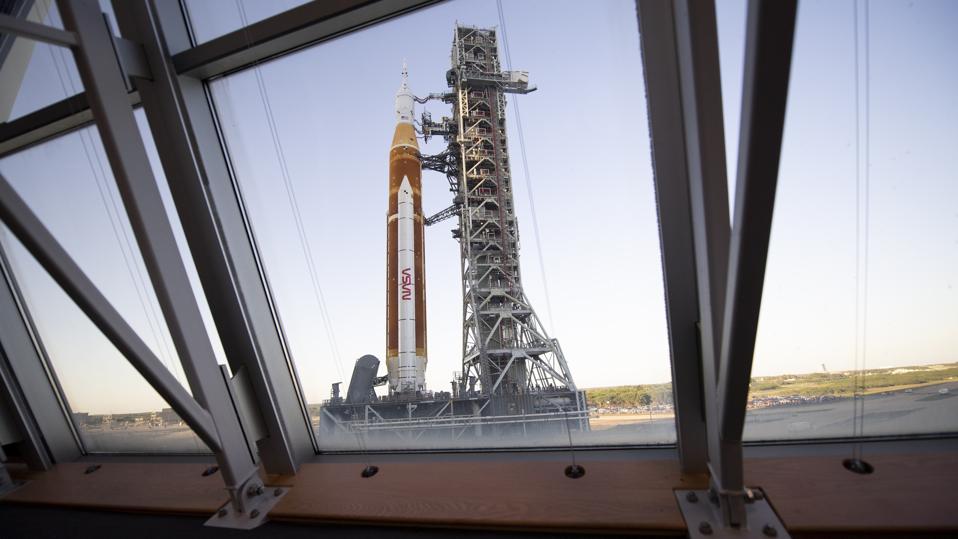Topline
North American astronauts slated to visit the moon as part of the Artemis II mission in 2024 could face further delays as NASA’s Orion spacecraft is being investigated; once cleared, it will take flight with the Space Launch System—a powerful rocket that is the foundation of the Orion spacecraft and will be launched alongside it—with both expected to return within 10 days, but here are the problems the Artemis missions have run into.
Timeline
NASA launches the Orion spacecraft for the first time, but with Delta IV heavy-rockets on a journey to Mars instead of the Space Launch System that was used for the later Artemis missions; the flight test was successful.
The Artemis program, originally called Exploration Mission-1, is officially launched by NASA with the mission to visit the moon for scientific research purposes; the program was created to formally give a name to the celestial activities NASA had already been partaking in under a mandate from then-President Donald Trump’s Space Policy Directive 1, which was created to ensure that the U.S., under NASA, would return to the moon.
Artemis I’s original launch date was scrubbed because of engine issues, delaying the spacecraft’s departure for the first time that week.
NASA officials discover a liquid hydrogen leak during their second attempt to launch the rocket, and are adamant they won’t risk launching the spacecraft until the perfect time.
The Artemis I launch is again postponed—this time in response to Hurricane Ian, which was projected to hit Florida, the home of Kennedy Space Center, where the craft would be launching from.
NASA originally has plans to launch the spacecraft, but the departure is again delayed by the elements, this time because of Tropical Storm Nicole, which was expected to hit Florida’s East Coast exactly where the space center was located.
After four delays, NASA launches the Orion spacecraft (uncrewed) as part of the flight-test Artemis I mission along with the SLS after 15 years of tests.
The Artemis I mission completes with the return of the spacecraft and no apparent damage, suggesting that it is safe to be launched with humans in Artemis II.
It is revealed that the Artemis heat shield was damaged in the first mission the previous year, and, according to NASA’s website, before the Artemis I mission sent the Orion spacecraft into space, the heat shield was already a major area of concern. The shield is built to withstand about 5,000 degrees Fahrenheit, “about half as hot as the sun,” as it reenters the Earth’s atmosphere on its return.
NASA and the Canadian Space Agency reveal the crew that will fly to the moon in the Artemis II mission in November 2024, naming Reid Wiseman, Victor Glover, Christina Hammock Koch and Jeremy Hansen as the astronauts who will board the spacecraft.
Artemis II’s new heat shield is installed, which is supposed to protect the spacecraft from the high temperatures of reentry into the atmosphere.
NASA investigates further and does not foresee the heat shield testing delaying the anticipated 2024 launch of Orion—though the previous mission was delayed numerous times and eventually pushed back months—and, according to NASA Space Flight, Artemis II will follow the same outline as its predecessor and the same concept of operations.
What To Watch For
Both Artemis I and II are considered the “stepping stones” for the Artemis’ third, fourth, and fifth missions, which will require only two crew members to board the spacecraft, one that may be SpaceX’s Starship vehicle, though more tests are being conducted to confirm that the vessel is safe to transport humans to space; the formal date of departure will be almost two years from now.
Key Background
The Artemis II launch, named after Apollo’s twin sister, will be the first time in more than 50 years that humans go to the moon, though those on the Artemis II will only be flying around it. The Artemis II mission is also full of firsts, including Glover, who will be the first person of color to go to the moon, Hansen, who will be the first Canadian, Koch, who’s set to become the first female astronaut to visit the moon, and Wiseman, who is tasked with commanding the first lunar mission since Apollo 17 in 1972. According to NASA’s website, the objective of the Artemis II mission as the first crewed journey to the moon in over half a century is “to establish a long-term presence at the Moon for science and exploration.” The Soviet Union, China, Japan and Italy have all taken their respective trips to the moon throughout history. India is the most recent country to attempt to visit the rock, successfully launching a spacecraft on a path to the moon just last month, according to CNN.
Crucial Quote
Wiseman told Popular Science: “Our focus is on what we can do to enable our co-workers to operate in the lunar environment, whether it’s on the Gateway outpost [a space station NASA plans to build in lunar orbit beginning in 2024] or the lunar surface.”

